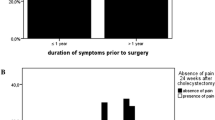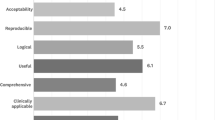Abstract
Purpose
Over the last few decades, laparoscopy has become a standard procedure within gynecological surgery. Validated quality indicators for the determination of the objective (perioperative complications) and subjective (patient satisfaction) quality of treatment as a surrogate parameter for the success of the treatment have so far found no regular application in the clinical routine. The purpose of this study was to evaluate the use of the Clavien-Dindo (CD) classification for postoperative complications and the Picker Patient Experience Questionnaire (PPE-15) as tools in the evaluation of endoscopic therapies in clinical routine.
Methods
Retrospectively, perioperative complications using the CD classification and patient satisfaction utilizing the PPE-15 were reviewed for a total of 212 consecutive patients at a gynecologic endoscopic referral center (Agaplesion Diakonie Kliniken, Kassel, Germany) in September 2018.
Results
An overall complication rate of 13.21% (28 out of 138 patients) was observed. Five patients (2.36%) had complications grade III and above according to the CD classification system. 138 patients out of 212 chose to answer the PPE-15 (return rate 65.01%). 112 patients (81.16%) reported about problems during their treatment in our hospital in their PPE-15. “Purpose of medicines not explained” was the most mentioned item (28.99%) by patients during their hospital stay.
Conclusion
CD classification and PPE-15 may be helpful instruments to evaluate the quality of care in gynecology. The application of both instruments for the assessment of treatment quality in clinical routine should be further investigated in prospective studies.
Similar content being viewed by others
References
Gerabek WE, Haage BD, Keil G, Wegner W (2005) Enzyklopädie Medizingeschichte. Walter De Gruyter, Berlin
Boesch CE, Umek W (2009) Effects of wound closure on wound healing in gynecologic surgery: a systematic literature review. J Reprod Med 54(3):139–144
Szeverényi P, Bacskó G, Hetey M, Kovácsné TZ, Csiszár P, Kórösi T, Borsos A (1999) The healing process following gynecologic laparoscopy: data on the significance of psychological factors. Orv Hetil 140(19):1043–1048
Counte MA, Howard SW, Chang L, Aaronson W (2019) Global advances in value-based payment and their implications for global health management education, development, and practice. Front Public Health 6:379
Gemeinsamer Bundesausschuss. Richtlinie zu planungsrelevanten Qualitätsindikatoren: Veröffentlichung des Berichts (2017). https://www.g-ba.de/downloads/40-268-5374/2018-10-18_PlanQI-RL-QI-Bericht-2017_Anlage-2_gyn-OP.xlsx
Maurer PP, Ballmer PE (2004) Hospital readmissions–are they predictable and avoidable? Swiss Med Wkly 134(41–42):606–611
Alper E, O`Malley TA, Greenwald J (2019) Hospital discharge and readmission. UpToDate.
Dindo D, Demartines N, Clavien PA (2004) Classification of surgical complications: a new proposal with evaluation in a cohort of 6336 patients and results of a survey. Ann Surg 240:205–213
Radosa MP, Meyberg-Solomayer G, Radosa J, Vorwergk J, Oettler K, Mothes A, Baum S, Juhasz-Boess I, Petri E, Solomayer EF, Runnebaum IB (2014) Standardised registration of surgical complications in laparoscopic-gynaecological therapeutic procedures using the Clavien-Dindo classification. Geburtshilfe Frauenheilkd 74(8):752–758
Jenkinson C, Coulter A, Bruster S (2002) The Picker Patient Experience Questionnaire: development and validation using data from in-patient surveys in five countries. Int J Qual Health Care 14(5):353–358
Chi DS, Abu-Rustum NR, Barakat RR (2004) Ten-year experience with laparoscopy on a gynecologic oncology service: analysis of risk factors for complications and conversion to laparotomy. Am J Obstet Gynecol 191:1138–1145
Clavien PA, Sanabria JR, Strasberg SM (1992) Proposed classification of complications of surgery with examples of utility in cholecystectomy. Surgery 111:518–526
Härkki-Sirén P, Kurki T (1997) A nationwide analysis of laparoscopic complications. Obstet Gynecol 89:108–112
Besser L, Schwarzman P, Mastrolia SA, Rotem R, Leron E, Yohay D, Weintraub AY (2018) Comparative analysis of early adverse events of pelvic organ prolapse repair with or without transvaginal mesh using Clavien-Dindo classification. Int J Gynaecol Obstet 142(1):108–113
Katayama H, Kurokawa Y, Nakamura K, Ito H, Kanemitsu Y, Masuda N, Tsubosa Y, Satoh T, Yokomizo A, Fukuda H, Sasako M (2016) Extended Clavien-Dindo classification of surgical complications: Japan Clinical Oncology Group postoperative complications criteria. Surg Today 46(6):668–685
Mothes AR, Radosa MP, Runnebaum IB (2015) Systematic assessment of surgical complications in laparoscopically assisted vaginal hysterectomy for pelvic organ prolapse. Eur J Obstet Gynecol Reprod Biol 194:228–232
Pryor A, Mann WJ Jr, Bates AT (2019) Complications of laparoscopic surgery. UpToDate.
Di Saverio S, Birindelli A, Broek RT, Davies JR, Mandrioli M, Sallinen V (2018) Laparoscopic adhesiolysis: not for all patients, not for all surgeons, not in all centres. Updates Surg 70(4):557–561
Zuckerman RB, Sheingold SH, Orav EJ, Ruhter J, Epstein AM (2016) Readmissions, observation, and the hospital readmissions reduction program. N Engl J Med 374:1543
Forster AJ, Murff HJ, Peterson JF, Gandhi TK, Bates DW (2003) The incidence and severity of adverse events affecting patients after discharge from the hospital. Ann Intern Med 138:161
Were MC, Li X, Kesterson J, Cadwallader J, Aswira C, Khan B, Rosenman MB (2009) Adequacy of hospital discharge summaries in documenting tests with pending results and outpatient follow-up providers. J Gen Intern Med 24:1002
Delbanco T, Gerteis M (2019) A patient-centered view of the clinician-patient relationship. UpToDate.
Wirtz M, Farin E, Bengel J, Jäckel WH, Hämmerer D, Gerdes N (2005) IRES-24 Patientenfragebogen. Diagnostica 51:75–87
Magnusson I, Jeffcoat MK, Donaldson D, Otterbom IL, Henriksson J (2004) Quantification and analysis of pain in nonsurgical scaling and/or root planing. J Am Dent Assoc 135(12):1747–1754
Cleary PD, Edgman-Levitan S, Roberts M, Moloney TW, McMullen W, Walker JD, Delbanco TL (1991) Patients evaluate their hospital care: a national survey. Health Aff 10(4):254–267
Pelletier D, Green-Demers I, Collerette P, Heberer M (2019) Modeling the communication-satisfaction relationship in hospital patients. SAGE Open Med 7:2050312119847924
Staniszewska S, Haywood KL, Brett J, Tutton L (2012) Patient and public involvement in patient-reported outcome measures: evolution not revolution. Patient 5(2):79–87
Eberlein-Gonska M, Costa SD (2015) Qualitätsmanagement-integraler Bestandteil der täglichen Arbeit? Dtsch Ärztebl 112(8):A316
Harrison R, Walton M, Kelly P, Manias E, Jorm C, Smith-Merry J, Iedema R, Luxford K, Dyda A (2018) Hospitalization from the patient perspective: a data linkage study of adults in Australia. Int J Qual Health Care 30(5):358–365
Leonardsen AL, Grøndahl VA, Ghanima W, Storeheier E, Schönbeck A, Løken TA, Bakken NCM, Letting GS, Holst R, Jelsness-Jørgensen LP (2017) Evaluating patient experiences in decentralised acute care using the Picker Patient Experience Questionnaire; methodological and clinical findings. BMC Health Serv Res 17(1):685
Richards L, Healey M, Cheng C, Dior U (2018) Laparoscopic oophorectomy to treat pelvic pain following ovary-sparing hysterectomy: factors associated with surgical complications and pain persistence. J Minim Invasive Gynecol S1553–4650(18):31294–31299
Radosa JC, Radosa MP, Mavrova R, Rody A, Juhasz-Böss I, Bardens D, Brün K, Solomayer EF, Baum S (2013) Five minutes of extended assisted ventilation with an open umbilical trocar valve significantly reduces postoperative abdominal and shoulder pain in patients undergoing laparoscopic hysterectomy. Eur J Obstet Gynecol Reprod Biol 171(1):122–127
Leineweber C, Marklund S, Aronsson G, Gustafsson K (2019) Work-related psychosocial risk factors and risk of disability pension among employees in health and personal care: a prospective cohort study. Int J Nurs Stud 93:12–20
Tan TC, Zhou H, Kelly M (2017) Nurse-physician communication—an integrated review. J Clin Nurs 26(23–24):3974–3989
Author information
Authors and Affiliations
Corresponding author
Ethics declarations
Conflict of interest
We declare that we have no conflict of interest.
Ethical approval
The study was conducted in concordance to the ethical standards of the institution.
Informed consent
Only retrospective data from patient records were analyzed without any intervention. All patients gave their agreement in analyzing and publishing data anonymously before treatment.
Additional information
Publisher's Note
Springer Nature remains neutral with regard to jurisdictional claims in published maps and institutional affiliations.
Appendix
Appendix
PPE-15 items
1. If you asked important questions to a doctor, did you get clear answers?
2. If you asked important questions to nurses, did you get clear answers?
3. Sometimes it happens that a doctor or nurse says something, and another doctor or nurse tells you something else. Did that happen to you?
4. If you were worried or worried about your condition or treatment, did a doctor discuss it with you?
5. Did it happen that doctors in your presence talked about you as if you were not there?
6. Could you participate in your treatment?
7. Did you have the feeling of being treated with care and attention during your stay in hospital?
8. If you were worried or worried about your condition or treatment, did the nurses discuss it with you?
9. Was it easy to find someone from the hospital staff who talked to you about your concerns and concerns?
10. Did you have pain during this hospital stay?
11. Did your family or other people close to you have ample opportunity to talk to your doctor?
12. Has anyone informed your family or other people who are close to you how recovery can help you?
13. Did someone explain the purpose of the medication that you should take at home understandably?
14. Has anyone told you what side effects of these medicines you should look at home?
15. Has anyone told you what symptoms you should be aware of at home with regard to your illness or surgery?
Rights and permissions
About this article
Cite this article
Findeklee, S., Radosa, J.C., Schafhaupt, S. et al. Evaluating the use of Clavien-Dindo classification and Picker Patient Experience Questionnaire as quality indicators in gynecologic endoscopy. Arch Gynecol Obstet 300, 1317–1324 (2019). https://doi.org/10.1007/s00404-019-05302-w
Received:
Accepted:
Published:
Issue Date:
DOI: https://doi.org/10.1007/s00404-019-05302-w




